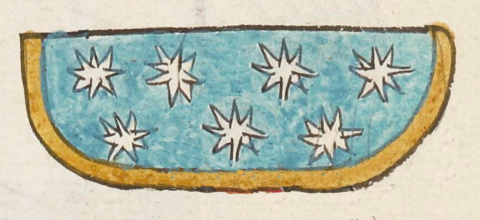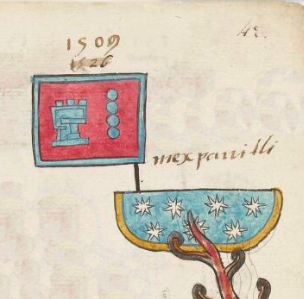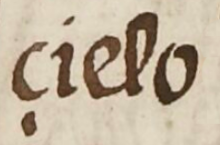ilhuicatl (TR42r)
This simplex noun represents the sky or heavens (ilhuicatl). It is nearly a half circle, with the diameter across the upper side. The curving part has a golden or yellow border. The rest of the shape is filled in with a turquoise blue and seven white stars of the type that show European influence, with eight points.
Stephanie Wood
The sky band, as depicted in the Codex Mendoza, shows a horizontal rectangle with various layers, which do not appear in this example here. The Mendoza example does have a turquoise blue layer (at the top) with white circles that represent stars.
The Florentine Codex conveys how the heavens or sky could be thought of as "a blue gourd bowl filled with popcorn." See: Fr. Bernardino de Sahagún, Florentine Codex: General History of the Things of New Spain; Book 6 -- Rhetoric and Moral Philosophy, No. 14, Part 7, eds. and transl. Arthur J. O. Anderson and Charles E. Dibble (Santa Fe and Salt Lake City: School of American Research and the University of Utah, 1961), 237.
Stephanie Wood
çielo
cielo
Stephanie Wood
1578
Jeff Haskett-Wood
skies, cielos, heavens, stars, estrellas

ilhuicac, heaven, https://nahuatl.wired-humanities.org/content/ilhuicac
The Codex Telleriano-Remensis is hosted on line by the Bibliothèque nationale de France.
https://gallica.bnf.fr/ark:/12148/btv1b8458267s/f109.item. We have taken this detail shot from the indicated folio.
This manuscript is not copyright protected, but please cite Gallica, the digital library of the Bibliothèque nationale de France or cite this Visual Lexicon of Aztec Hieroglyphs, ed. Stephanie Wood (Eugene, Ore.: Wired Humanities Projects, 2020–present).


